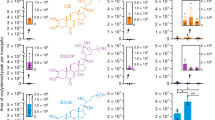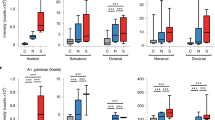Abstract
OVARIAN maturation by mosquitoes and other haematophagous Diptera without a prior blood meal is called autogeny, while the term anautogeny applies to those cases where blood is necessary. Many populations of the saltmarsh mosquito, Aedes taeniorhynchus, contain both autogenous and anautogenous females1–2. Moreover, within this species there are two types of autogenous females : (1) those that need a stimulus from mating to produce eggs autogenously and (2) those that lack this requirement3. We report that autogenous egg production associated with mating is triggered by a substance from the male accessory gland. The stimulation of normal oviposition behaviour and the termination of sexual receptivity in the female mosquito are also caused by a male accessory gland substance which is introduced into the female during mating4,5. Both of these responses are uniformly exhibited by all females of several species6.
This is a preview of subscription content, access via your institution
Access options
Subscribe to this journal
Receive 51 print issues and online access
$199.00 per year
only $3.90 per issue
Buy this article
- Purchase on Springer Link
- Instant access to full article PDF
Prices may be subject to local taxes which are calculated during checkout
Similar content being viewed by others
References
O'Meara, G. F. & Edman, J. D. Biol. Bull. 149, 384–396 (1975).
O'Meara, G. F. & Evans, D. G. Science 180, 1291–1293 (1973).
O'Meara, G. F. & Evans, D. G. J. Insect Physiol. 22, 613–617 (1976).
Craig, G. B., Jr Science 156, 1499–1501 (1967).
Leahy, M. G. & Craig, G. B., Jr Mosquito News 25, 448–452 (1965).
Leopold, R. A. Ann. Rev. Ent. 21, 199–221 (1976).
Hayes, R. O. J. econ. Ent. 46, 624–627 (1953).
O'Meara, G. F. & Evans, D. G. Anim. Behav. 22, 376–381 (1974).
Spielman, A., Gwadz, R. W., Anderson, W. A. J. Insect Physiol. 17, 1807–1814 (1971).
Hagedorn, H. H. Am. Zool. 14, 1207–1217 (1974).
Lea, A. O. J. Insect Physiol. 16, 1689–1696 (1970).
Fuchs, M. S., Craig, G. B., Jr, Despommier, D. D. J. Insect Physiol. 15, 701–709 (1969),
Hiss, E. A. & Fuchs, M. S. J. Insect Physiol. 18, 2217–2227 (1972).
Corbet, P. S. Nature 215, 662–663 (1967).
Edman, J. D. et al. Ann. ent. Soc. Am. 65, 848–852 (1972).
Lea, A. O. & Evans, D. G. Ann. ent. Soc. Am. 65, 285–289 (1972).
Author information
Authors and Affiliations
Rights and permissions
About this article
Cite this article
O'MEARA, G., EVANS, D. Autogeny in saltmarsh mosquitoes induced by a substance from the male accessory gland. Nature 267, 342–344 (1977). https://doi.org/10.1038/267342a0
Received:
Accepted:
Issue Date:
DOI: https://doi.org/10.1038/267342a0
This article is cited by
-
Blood feeding habits of mosquitoes: hardly a bite in South America
Parasitology Research (2022)
-
Evolution of sexually-transferred steroids and mating-induced phenotypes in Anopheles mosquitoes
Scientific Reports (2019)
-
Nutrition and reproduction in haematophagous arthropods
Proceedings: Animal Sciences (1987)
Comments
By submitting a comment you agree to abide by our Terms and Community Guidelines. If you find something abusive or that does not comply with our terms or guidelines please flag it as inappropriate.



